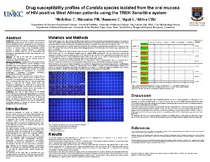| dc.contributor.author | McArthur, Carole P. | |
| dc.contributor.author | Abrantes, Pedro Miguel dos Santos | |
| dc.contributor.author | Awasom, Charles | |
| dc.contributor.author | Ayuk, L. | |
| dc.contributor.author | Africa, Charlene W.J. | |
| dc.date.accessioned | 2014-07-30T13:01:33Z | |
| dc.date.available | 2014-07-30T13:01:33Z | |
| dc.date.issued | 2013 | |
| dc.identifier.citation | McArthur, C.P., et al. (2013). Drug susceptibility profiles of Candida species isolated from the oral mucosa of HIV-positive West African patients using the TREK Sensititre system. American Society for Microbiology 113th General Meeting, 199/2335, Denver, Colorado, U.S.A, 18-21 May 2013 | en_US |
| dc.identifier.uri | http://hdl.handle.net/10566/1138 | |
| dc.identifier.uri | www.asm.org/asm2013 | |
| dc.description | Poster presented at ASM2013, 113th General Meeting, American Society of Microbiology, 18-21 May, Denver, Colorado | |
| dc.description.abstract | BACKGROUND: Candida infections are a common cause of death in
immunocompromised patients. The prevalence and anti-mycotic
drug susceptibility profiles of Candida species from Cameroon in
Africa are unavailable. This study was prompted by an increasing
incidence of treatment failure. Drug susceptibility profiles,
necessary to improve treatment outcomes, is particularly
important in countries where the sale of antimicrobials and
antifungals is uncontrolled and resistance may emerge due to the
indiscriminate use.
OBJECTIVE: The goal of this study was to characterize and
determine drug susceptibility of oral Candida species in
Cameroonian patients with HIV/AIDS.
MATERIALS AND METHODS: Candida species were isolated from the
oral cavity of 126 HIV-positive patients attending a local
HIV/AIDS clinic in the Cameroon. Drug susceptibility to azoles
and echinocandins was determined using the commercial TREK
Sensititre® YeastOne™ platform that provides the minimal
inhibitory concentration of amphotericin B, 5-flucytosine,
anidulafungin, caspofungin, micafungin, fluconazole,
itraconazole, posaconazole, and voriconazole.
RESULTS: Ninety two isolates identified were Candida albicans.
Remaining isolates were C. glabrata (24), C. tropicalis (4), C.
krusei (3), C. parapsilopsis/lusitanreae/keyfr (2), and one isolate
was C. dubliniensis. More than 50% of C. albicans isolated were
resistant to azoles but 115 Candida species (87%) were
susceptible to amphotericin B. Twenty one of the twenty four
C.glabrata identified (88%) were resistant to micafungin. The
majority of Cameroonian Candida species were sensitive to
flucytosine (5-FC) (95%) and echinocandins (79%).
CONCLUSIONS: The report of azole resistance in all Candida
species isolated from immunocompromised patients in Cameroon
is a new and important observation. We found the approach using
a broad screening platform an effective means to obtain data
rapidly. We propose confirmation of these data and regional
surveillance of Candida species in other areas in Cameroon and
surrounding countries to develop an effective public health
management and treatment strategy. | en_US |
| dc.language.iso | en | en_US |
| dc.rights | This file may be freely used for educational uses, as long as it is not altered in any way. No commercial reproduction or distribution of this file is permitted without written permission of the authors. | |
| dc.subject | Candida | en_US |
| dc.subject | azoles | en_US |
| dc.subject | echinocandins | en_US |
| dc.subject | antifungal drugs | en_US |
| dc.subject | drug resistance | en_US |
| dc.subject | TREK | en_US |
| dc.title | Drug susceptibility profiles of Candida species isolated from the oral mucosa of HIV-positive West African patients using the TREK Sensititre system | en_US |
| dc.type | Poster | en_US |
| dc.privacy.showsubmitter | false | |
| dc.status.ispeerreviewed | true | |

